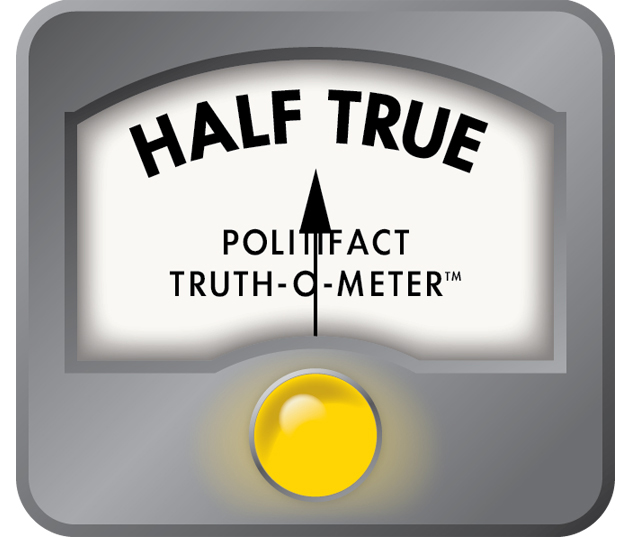Stand up for the facts!
Our only agenda is to publish the truth so you can be an informed participant in democracy.
We need your help.
I would like to contribute
Is Michelle Wolf right that Flint still doesn’t have clean water?
The remarks by comedian Michelle Wolf at the White House Correspondents' Dinner were intensely scrutinized by journalists, commentators and users of social media.
We don’t fact-check jokes, but we did want to look at one line by Wolf that seemed to be dead serious. At the end of her monologue, Wolf said, "Flint still doesn’t have clean water."
She’s referring to the woes of Flint, Mich., where a switch in water sources was improperly handled, leading to unsafe levels of lead in the city’s water system.
We’ve periodically checked in to see how Flint’s water problems are progressing, but the last time we looked was in late 2016. So, now that Wolf has used Flint’s situation as an exclamation point for her high-profile remarks, we decided to gauge whether she’s right that "Flint still doesn’t have clean water."
Ultimately, we concluded that the reality is more nuanced than Wolf portrayed it. (We reached out to Wolf’s representatives but did not hear back.)
Flint is a low-income and majority African-American city beset by a decline in its manufacturing industry. The city’s lead poisoning was precipitated by Gov. Rick Snyder. Snyder, a Republican, had campaigned on his managerial experience and promised to bring outside experts to transform financially languishing municipalities.
Under an emergency manager appointed by the state, the city ended its agreement to obtain water from the Detroit Water and Sewerage Department and instead joined a new pipeline project, the Karegnondi Water Authority, that would draw water from Lake Huron. The move, made officially in April 2013, was done in large part to save the city millions of dollars.
The day after the switch was announced, the Detroit Water and Sewerage Department said it would cut off service in April 2014. Since the pipeline wouldn’t be ready by then, the city prepared to switch its water supply to the Flint River. However, the river water contained salts that would corrode pipes, and the right mix of corrosion inhibitors was never used.
Not only did residents complain that their new water was foul, but it eventually became clear that lead was leaching into the water supply from the city’s old pipes.
Lead is a highly toxic metal, especially for children whose bodies are still developing.
After a litany of missed opportunities, the situation became a focus of the national media in the second half of 2015, prompting both emergency water distribution and a search for a longer-term solution.
Flint faces two issues around its water supply: the quality of the water itself, and the effort to remove pipes that contain lead.
First, let’s take a look at water quality.
By July 2016, the federal Environmental Protection Agency had found significant reductions in lead levels, as long as residents used filters that were provided free of charge. Since then, there have been further improvements.
Featured Fact-check
A regulation known as the Federal Lead and Copper Rule set the safe limit for lead in water at 15 parts per billion in 90 percent of samples, using specific testing procedures. Most tests with these procedures in Flint have found that "lead levels have fallen to legally safe levels," said Peggy Kahn, a University of Michigan-Flint political scientist who has closely tracked the issue.
Tests conducted in 2017 over a seven-month period by Susan J. Mastern of the Department of Civil and Environmental Engineering at Michigan State found lead levels that met the federal standard.
Marc Edwards is a Virginia Tech environmental and water resources engineer who leads the Flint Water Study team, which helped identify the problem in the first place. His team also conducted tests in late 2017 and found lead levels below the legal threshold.
So there’s solid evidence that Flint’s water is in compliance with federal regulations. That said, no level of lead is truly safe. Even the legal lead level for water does not fully protect children’s health, Kahn said, especially when there are other environmental sources of lead.
"There is no such thing as perfectly safe water anywhere in the U.S.," Edwards said. "Even bottled water sometimes has health risks."
Progress on replacing old, unsafe pipes has been slower.
In March 2016, Flint began to rip out and replace some of the hazardous pipes under a "FAST Start program." That program continues.
Kristin Moore, a Flint city government spokeswoman, said that 6,264 pipes have been replaced as of April 18, 2018. However, an estimated 12,000 Flint residences still have lead and galvanized service lines that need to be replaced, she said.
"The pipe replacement work is expected to be completed by 2020," Moore said. "However, the mayor is hopeful that the project can be completed even sooner."
One factor slowing the work is that "individual home tests may vary even within the same neighborhood," due to differences in how the original pipes were laid, said Kimberly Saks McManaway, director of the master’s of public administration program at the University of Michigan-Flint.
The consensus we found is that the water quality in Flint is greatly improved, but the city is not out of the woods yet.
"While progress indeed continues to be made in Flint, Mayor Karen Weaver has said that there are still issues that must be addressed," said Moore, the city spokeswoman.
She said residents are urged to drink water that is filtered and to keep their filters properly maintained, adding "some with health issues or compromised immune systems may be advised by medical professionals to drink bottled water."
That said, Flint’s water quality now exceeds that of other cities with old water pipes, Edwards said.
Kahn agreed that there has been "great improvement" compared to the worst of the crisis. However, she added that "there are still significant safety concerns, and there is a deep level of mistrust in view of some of the recent testing results and warnings, terrible past damage, unresponsiveness, and cover-ups."
Wolf said, "Flint still doesn’t have clean water."
In reality, testing in recent months has repeatedly shown that Flint’s water meets federal standards. At the same time, the city won’t be fully safe until its old pipes are all replaced, which is currently estimated to happen in 2020.
Considerable hurdles remain for Flint, but Wolf’s statement glossed over the significant progress made in water quality since the worst of the crisis. We rate her statement Half True.
Our Sources
Vox.com, "Wonder what Michelle Wolf said to make everyone so mad? Read it here," April 30, 2018
Flint Water Study, "Another Set of Independent Lead and Copper Rule Testing Results for Flint, MI," April 13, 2018
PolitiFact, "Who's to blame for the Flint water crisis?" Feb. 15, 2016
PolitiFact, "Flint water still has problems, but Michael Moore minimizes progress made," Nov. 21, 2016
Email interview with Kimberly Saks McManaway, director of the master’s of public administration program at the University of Michigan-Flint, April 30, 2018
Email interview with Peggy Kahn, University of Michigan-Flint political scientist, April 30, 2018
Email interview with Marc Edwards, a Virginia Tech environmental and water resources engineer who leads the Flint Water Study team, April 30, 2018
Email interview with Kristin Moore, communications and public information officer with the City of Flint, April 30, 2018
Browse the Truth-O-Meter
More by Louis Jacobson
Is Michelle Wolf right that Flint still doesn’t have clean water?
Support independent fact-checking.
Become a member!
In a world of wild talk and fake news, help us stand up for the facts.










 PolitiFact Rating:
PolitiFact Rating: 









































